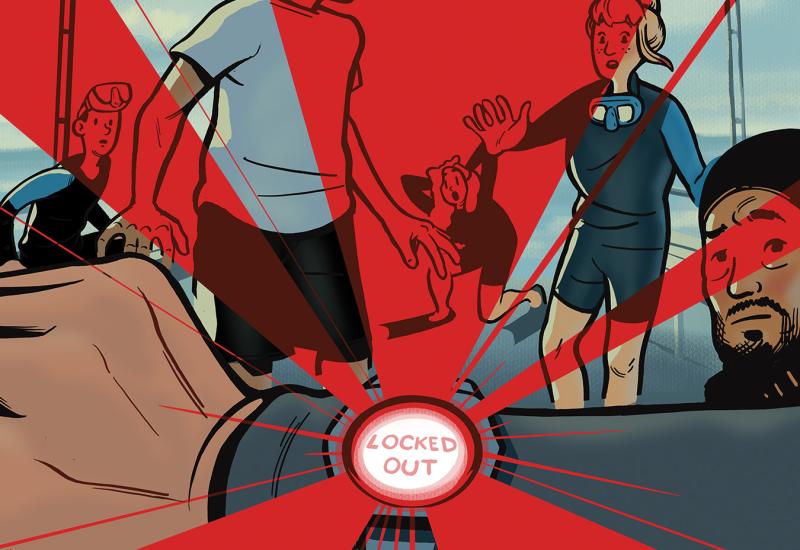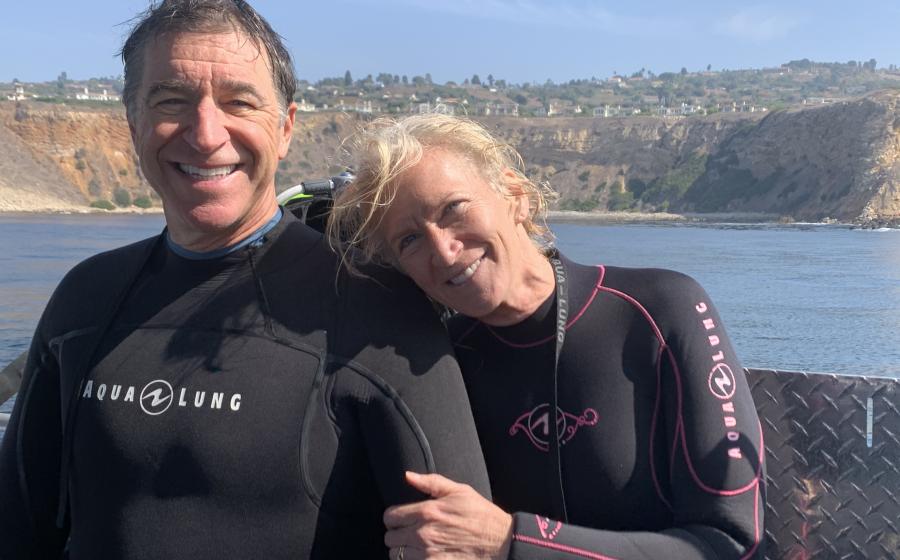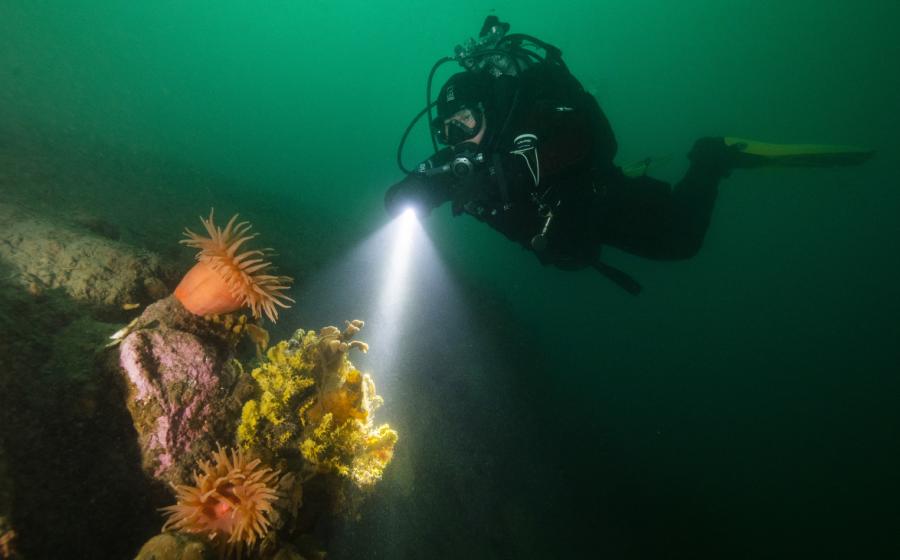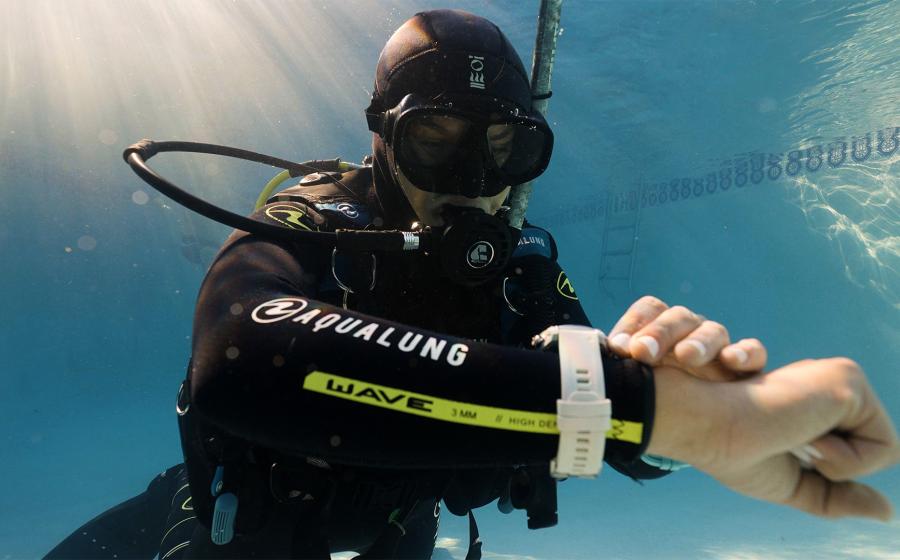Here's How to Improve Your Trim While Scuba Diving

ANNIE CRAWLEYMastering the art of perfect trim will allow you to focus on the wildlife surrounding you as you glide effortlessly through the water.
The feeling of “weightlessness” is the golden elixir of diving. Divers often focus on finding neutral buoyancy, but body positioning—or trim—is just as important for good air consumption, ease of movement, and orientation in the water. Perfect trim for divers means you are horizontal in the water, have all your hoses and gauges tucked in place, and you use your legs to turn and propel you easily through the water. Proper body positioning reduces your drag in the water. The art of achieving trim starts from the moment you descend.
After you deflate your BCD or drysuit completely on the surface, lower your shoulders and let the weight of your tank and weights push you toward the bottom. You’ll need to add air to your BCD to compensate as you become more negative. As you descend, engage your lower back and butt to help lift your legs and fins up as you slide into a horizontal position parallel with the bottom. This horizontal position is called neutral trim.
Once neutrally buoyant, you should be able to hover in one place as you descend, without feeling the need to use your arms, breathe deep or kick your legs to keep your body up and off the bottom. If you are having trouble with this skill, do a weight check to determine if you are over- or underweighted.
Remember that if you do a weight check with a full cylinder, you will need to add about two to six pounds of weight, depending on the tank, to compensate for the weight of the gas you consume during the dive. Mastering trim and understanding how to break trim in order to release air from your BCD are skills every diver can achieve.
Trim Specifics
The physics of diving are simple. Air spaces compress as you descend, and expand as you ascend. However, it is very rare to descend, maintain one depth throughout your dive and ascend at the end. You will need to add and release air throughout the dive as you change depths, and you will also need to adjust your trim in response to the site you are diving.
For instance, imagine you are swimming along a reef and come across a large coral that you want to swim over. Assuming you are neutrally buoyant, you will swim in the direction your shoulders point. Adjust your trim so that your shoulders are slightly higher than your fins. This position is called positive trim, and it will cause your fins to propel your body up so that you don’t have to add or release air from your BCD. After you pass the coral bommie, adjust your trim so that your shoulders are lower than your fins. This is negative-trim position. By kicking your fins, your body will follow. The positioning of your shoulders impacts your trim.
Equipment
In order to achieve perfect trim, you need to understand how different pieces of equipment impact your body position. The more familiar you are with your equipment, the easier it is to dive. It takes about eight to 10 dives (relatively close together) to truly feel comfortable when you change your exposure suit.
The positioning of the BCD on your tank, the material of the tank itself, and your weight system affect trim. Try on a variety of BCDs with a dive professional until you find one that’s comfortable and fits properly with your exposure suit. If a BCD is too big or too small, it’s difficult to maintain proper in-water positioning.
Different BCD styles suit different body types and change body positioning. Many divers start with rental BCDs that are a looser jacket style and less expensive than the more streamlined back inflate models with lots of straps to adjust the fit. No matter what style you choose, take time to center your BCD on your tank, ensuring you balance your weight system.
Most BCDs today are weight-integrated, with options for both back and front weight pouches. Often the trim pockets in the back are positioned higher than the integrated weight pockets in the front. If you notice you tend to be in a head-up position in the water, move some weight from your front weight pockets to your back trim pockets to push your torso down, and lift hips up to meet your tank. If your legs and hips still feel like they drag, you might be overweighted.
If you are diving in cold water with a steel tank, you may feel pulled backward by your tank. Try wearing a few extra pounds in the front weight pouches to help adjust body position. You can also attach 1- or 2-pound trim weights to the D-rings on your shoulders to get you into neutral-trim position. Eventually you’ll want to take these off, but this helps beginners stay in a streamlined position.
Breaking Trim
Throughout your dive you may need to get all the air out of your BCD or drysuit. This will require you to break trim. Use your fins to pivot from the hips, drop your legs to bring your shoulders and head up, and dump the air. Although BCD and dry-suits differ slightly, all main dump valves are on the left side. Remember that when you dump air, you have less control over the amount of air going out. Anytime you break trim to dump air, immediately get back into trim and check buoyancy.
Physical Fitness
Being physically fit helps you master neutral buoyancy and trim. I always recommend divers build up to 20 pushups a day to help develop body strength. Mastering buoyancy and trim helps protect fragile underwater environments and maximizes fun for every aspect of your diving life!
PRO TIP: Every time you equalize your ears, check your buoyancy. If you pay close attention to what your ears are doing and the depth on your computer, you will adjust your trim until it becomes a habit throughout your dive, not only on the way up and down.










